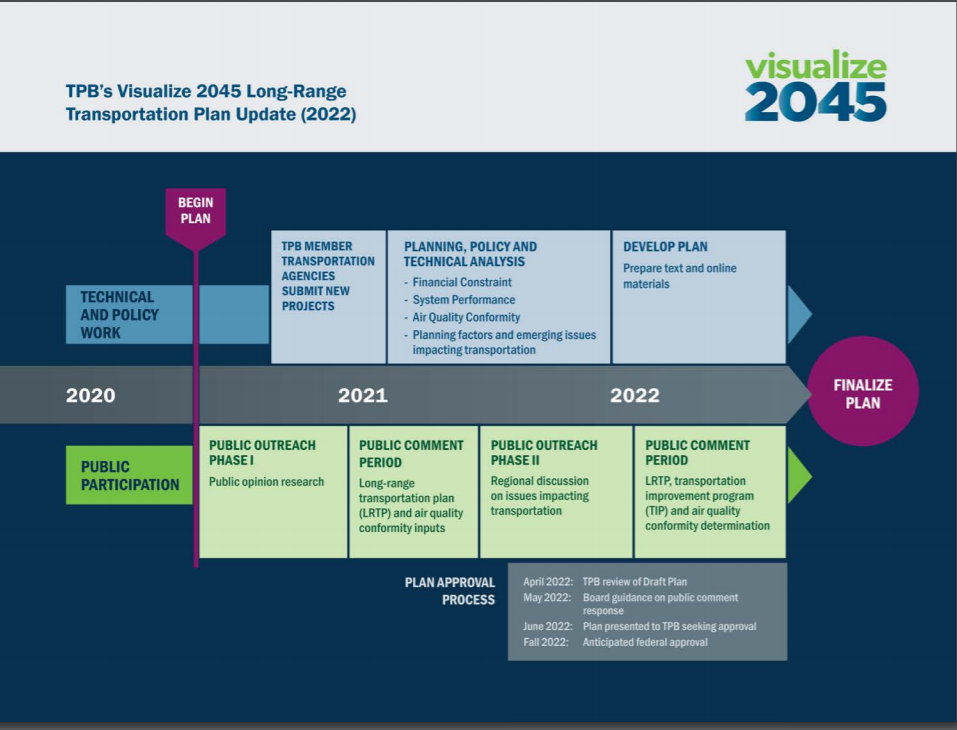At its September meeting the TPB approved an amendment to the Transportation Improvement Program for the District of Columbia. The meeting also included briefings covering the process to set Transit Safety Targets as part of Performance Based Planning and Programming, and updates on the Participation Plan, Visualize 2045, and an employer survey on telework during the COVID-19 pandemic.
Action Item
Transportation Improvement Program (TIP) Amendment for the District of Columbia
The only action item on the TPB’s agenda for its September meeting was an amendment to the DC portion of the Transportation Improvement Program (TIP). The TIP is a federal obligation document which describes the planned schedule in the next six years for distributing federal, state, and local funds for state and local transportation projects. The TIP represents an agency’s intent to construct or implement specific projects in the short term and identifies the anticipated flow of federal funds and matching state or local contributions. It is a multimodal list of projects that includes highway projects, rail, bus and streetcar projects, and bicycle and pedestrian improvements. It also includes roadway and transit maintenance projects, operational programs, and many other transportation-related activities.
The District Department of Transportation updated a number of projects including the Long Bridge project in its portion of the TIP. The TPB approved the amendment.
Watch and listen to the presentation and approval of the TIP amendment for DC.
Setting Transit Safety Targets
As part of federally required Performance Based Planning and Programming metropolitan planning organizations like the MPOs must set regional targets for transit safety. This is the first year the TPB will be setting targets for this measure. The targets will be based on the targets reported by select transit agencies in the region.
Learn more about the Transit Safety Targets
TPB staff have been coordinating with the transit operators in the region and will be finalizing the targets for board approval in November.
During the board discussion, Board member Kacy Kostiuk asked for clarification about how the data is collected for injuries and fatalities on transit. She asked if a person were injured or killed while disembarking from a bus for example, would they be included in this data as a transit safety incident or would it classify as a roadway incident. Staff explained that when it comes to classifying data like that, it depends on how it is reported at the time of the incident. If the bus driver struck a pedestrian that usually gets reported as a transit safety incident but it depends on the reporting and data collection at the scene.
Get the full presentation.
Watch and listen to the presentation and board discussion.
Learn more about the Transit Safety Target setting.
An update on Visualize 2045
The board received an update on Visualize 2045, the TPB’s long-range transportation plan. Staff briefed the board on a series of site visits to jurisdiction transportation and land-use planning staff. The site visits were a chance for TPB staff to learn from jurisdiction staff about the work that’s been happening on the local level to further the TPB’s aspirational initiatives. These were a set of ideas that together can help the region meet its transportation goals. This work is one of the ways that TPB staff have been working with its member jurisdictions to implement the 2018 long-range transportation plan.
Next, TPB staff are also looking ahead and beginning to lay the groundwork for developing the next long-range transportation plan for 2022, also named Visualize 2045. Staff are thinking through ideas for new topics to be included in the plan and is beginning some public participation for the 2022 plan. Next month a randomly selected sample of people in the region will received letters in the mail to participate in a survey to find out what they think about our region’s transportation system. This survey will help inform decisions at the local and regional level. Also, in the presentation staff shared the timeline for the 2022 plan.

This is a graphic representation of the timeline for the 2022 update to Visualize 2045. (TPB)
Get the full presentation.
Watch and listen to the presentation and board discussion.
Commuter Connections Employer Survey
Every three years Commuter Connections surveys employers in its database, this year staff had the opportunity to add a series of questions about telecommuting during the COVID-19 pandemic. Questions on the survey covered opinions and experienced about teleworking both before the stay-at-home orders, during, and when they expect to return to work. Some takeaways included that 96% of employers surveyed either shut down or partially shutdown since the covid-19 pandemic began. 50% of employers experience problems with telework but most of these were issues with employees’ experiences with telework like childcare. And, 92% of employers said they found telework to be a benefit.
Get the full presentation.
Watch and listen to the presentation and board discussion
Learn more about the Commuter Connections survey
Other Items
Participation Plan: TPB staff are updating the TPB’s Participation Plan. The Participation Plan updates include updates to our participation policy to add an equity lens, a new public guide, and a guide to help staff. Currently the Participation Plan update draft is out for public comment until October 9. Learn more at mwcog.org/TPBcomment. Get the presentation. Watch and listen to the presentation and discussion.
Citizens Advisory Committee: CAC Chair Nancy Abeles presented the CAC report. The Committee met on September 10. It received briefings on the TPB’s equity work, the Participation Plan update, and an update on Visualize 2045. Staff also discussed a notice item that they are working on restructuring the committee and will be coming back to discuss that at a future meeting. Read the CAC report. Watch and Listen to the presentation.